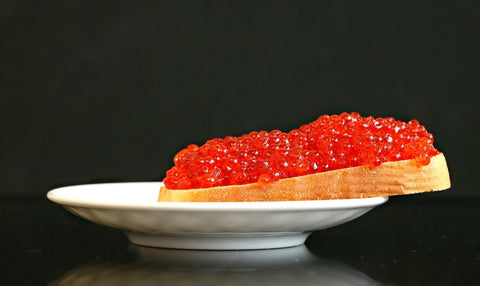When we talk about caviar, we’re really referring to a very specific delicacy: the salted roe of sturgeon, traditionally sourced from the Caspian Sea. Anything else? Technically not caviar. Out of over 30,000 species of fish swimming in Earth’s waters, only 27 produce the kind of roe that qualifies as true caviar. That leaves a whole ocean of options that fall into the category of caviar substitutes. With so many roe-producing fish out there, it’s no surprise these alternatives vary widely in flavor, texture, and how they’re used in the kitchen.
So what really sets the real thing apart from its substitutes? Let’s take a closer look at the key differences between caviar vs caviar substitutes, plus how to find a worthy alternative if you're not quite ready to splurge.
How Do Caviar Substitutes Stack Up to Sturgeon Caviar?
True sturgeon caviar is all about nuance. Whether it’s the nutty, buttery character of Osetra or the clean, briny finish of Siberian sturgeon, real caviar offers a depth and complexity that’s hard to replicate. It’s refined, delicate, and designed to be savored slowly.
Caviar substitutes, on the other hand, tend to be bolder in flavor. Non-sturgeon roe is often saltier, with a more assertively “fishy” taste. That’s not a flaw—it’s simply a different experience. Many of these roe types bring their own charms to the table.
Salmon roe (ikura), trout roe, whitefish roe, and tobiko (flying fish roe) are among the most popular substitutes. Salmon and Trout eggs are generally larger and more vibrant in color, ranging from pale gold to fire-orange. Flavor-wise, they’re typically mild with a straightforward taste of the sea, burst of sweet salinity. What they lack in complexity, they make up for in texture, offering a satisfying pop that’s perfect for infusing, garnishing, deviled eggs, or blinis. Whitefish and tobiko both offer a tiny egg with a crunchy "pop", best for sushi and garnishing to add color and crunchy texture, and a tiny bit of mild brine.
When a Substitute Comes Close: Paddlefish Roe
While most caviar alternatives veer noticeably from the sturgeon experience, some come remarkably close. One of the best examples is American Paddlefish roe. Although paddlefish isn’t technically a sturgeon, it belongs to a closely related family. Its eggs are similar in size and color to true caviar and deliver a taste that’s surprisingly authentic.
Paddlefish roe is prized for its subtle, earthy flavor and smooth, buttery texture—qualities that make it a top-tier alternative for those seeking a refined caviar experience at a more accessible price point. It’s a favorite among chefs and connoisseurs alike, particularly in the U.S.
Understanding Caviar Labels: Why Species Matters
One of the biggest sources of confusion in the world of caviar is labeling. In the United States, the term “caviar” is often used loosely to describe any salted fish roe. You’ll frequently see labels like “red caviar” for salmon roe, or “golden caviar” for whitefish. While these products are delicious in their own right, they don’t meet the traditional or European definition of true caviar, which must come from sturgeon.
This makes it all the more important to read labels carefully. If authenticity is what you’re after, look for the species name. True caviar comes from fish like Beluga (Huso huso), Osetra (Acipenser gueldenstaedtii), Sevruga (Acipenser stellatus), or Siberian Sturgeon (Acipenser baerii).
Choosing the Best Caviar Alternative
Whether you're curious about caviar or working with a budget, high-quality substitutes can still offer an elevated culinary experience. Here are some excellent options to consider:
- Paddlefish Roe: Closest in flavor and texture to traditional caviar. A fantastic gateway to the world of sturgeon. Expect less "creamy" or "buttery" notes and more minerals & earth.
- Salmon Roe: Bright and briny with large, juicy eggs. Ideal for sushi or topping canapés.
- Trout Roe: Smaller and more delicate than salmon, with a mild, clean taste and vibrant golden color.
- Whitefish Roe: Tiny, crisp eggs with a gentle flavor. Great for adding a pop of color and crunch to appetizers.
- Tobiko: Flying fish roe often used in sushi. Crunchy and fun, sometimes flavored with wasabi, yuzu juice, or colored for vibrant visuals.
Caviar vs Caviar Substitutes: The Bottom Line
Ultimately, whether you choose real caviar or one of its substitutes depends on your palate, budget, and the culinary experience you're seeking. While nothing can quite replicate the elegance of true sturgeon caviar, there’s a whole world of roe out there that offers unique flavors, textures, and uses.
We offer both authentic caviar and carefully selected alternatives for every kind of enthusiast—from first-timers to seasoned aficionados. Whether you're exploring paddlefish roe for the first time or looking to elevate your next celebration with Osetra, we’ve got you covered.
Ready to try the best? Buy caviar online now and discover your new favorite indulgence.


